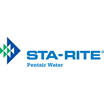
May 3rd, 2023
When it comes to increasing the water pressure for your fire sprinkler system, installing fire water pumps is a great solution. They are designed to maintain and supply adequate water pressure from public mains, gravity tanks, reservoirs, or other sources. The entire fire pump system consists of a pump, motor, driver, controller, and accessories.
A fire pump itself is the provider of water pressure. Its driver mainly consists of either a diesel engine or an electric motor to provide the energy needed for the pump to spin and move the water. There are some different types of fire pump systems that you can consider.
Vertical turbine pumps are designed to pump water out of a static water source, such as an underground water tank or well. They are the only pump that doesn’t require any source of water coming into the pump, known as suction pressure.
Positive displacement pumps boost water pressure by filling a cavity with water. Then, the pump pushes it out. Such types of pumps can create higher pressures than a centrifugal pump and are generally found as part of water mist.
Centrifugal pumps boost pressure by using centrifugal forces, which are outward forces created by rotating an object. This increases the velocity of the water through the rotation of impellers inside the fire pump.
The power source for driving your fire water pumps is selected based on reliability, adequacy, safety, availability, and economy. For instance, if you need a fire pump in a remote area where electricity is not available, you can choose from diesel or steam engines. Below are the main types of fire pump drivers:
Diesel engines require batteries to power the electric start of the engine. They are required to have a fuel storage tank and are currently the only type of internal combustion engine permitted by NFPA 20. These engines are best for larger applications and open spaces in remote locations.
Electric motors are the most common mean to supply power to fire water pumps. They are best for smaller applications, such as residential buildings, high-rise structures, hospitals, schools, and hotels.
One of the most traditional sources of energy, steam turbines, use steam as a driver for fire pumps. They are not as common as electric drives or diesel engines. This is simply because steam is not readily available these days.
Fire pumps are required to provide and maintain adequate water pressure, which can be done by using a fire pump controller. A fire pump controller is a group of devices that controls the starting and stopping of the fire pump driver.
It monitors the signal and condition of the fire pump unit system. You can enhance the existing water supply pressure for a fire protection system, and there is no need to worry about unnecessary pump functions.
Please note that the controller for a multistage multiport fire pump should have a dedicated pressure sensor. It has to be in the form of either a switch or an electronic sensor. It needs to have a dedicated pressure recorder for each stage of the fire pump. Plus, separate sensors and recorders should be in place as the system may see a pressure drop during a fire event.
Most commonly, fire pump controllers are connected to the fire protection system by means of a sensing line. Each fire pump should have its own individual controller, and each controller should have its own individual sensing line. Sensing or pilot lines are connected to the fire protection system between the pump discharge check valve and the discharge control valve.
A sensing line should be made of non-corrosive metallic pipes or tubes, such as brass, copper, or stainless steel. Avoid using galvanized pipes that are not corrosion-resistant. Plastic pipes are corrosion-resistant, but they can be easily damaged.
Install two check valves in each sensing line to absorb pressure surges and protect the pressure switch from any potential damage. These check valves should be at least five feet apart from each other.
Fire pump pressure relief valves and pumps are the backbone of any fire protection system. Without them, your system would be lost in the event of a fire. So, make sure you know your fire pump needs and have a clear plan in place.
Contact us for more details regarding fire pump systems.
john@callaghanpump.com,
eileen@callaghanpump.com,
dan@callaghanpump.com,
sales@callaghanpump.com,
service@callaghanpump.com












